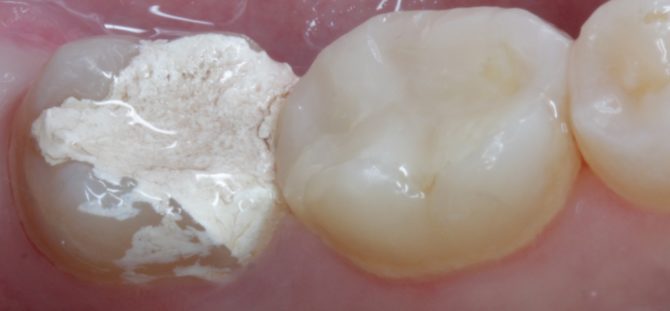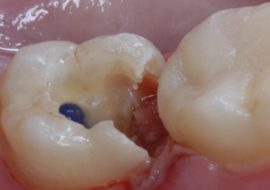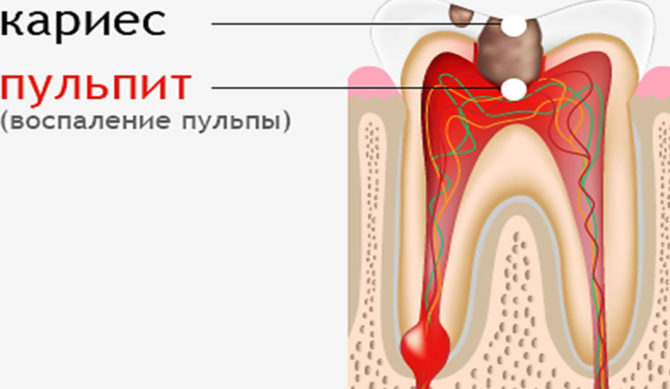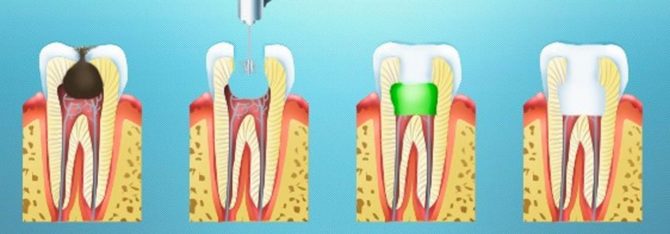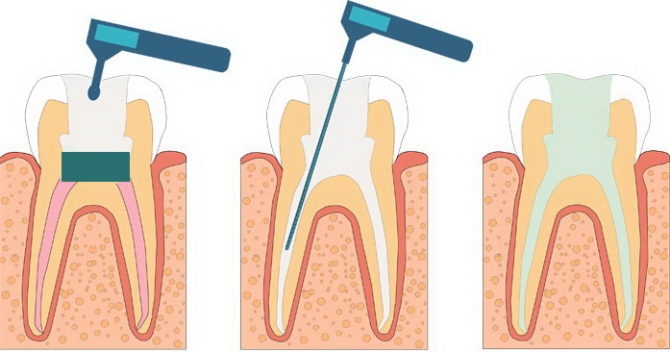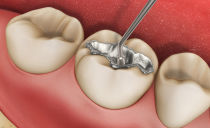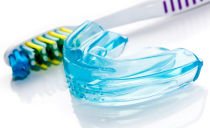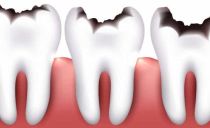Arsenic in the tooth: why they put it, how much adults and children can hold, how it works, possible complications
Arsenic is used in dentistry when it is necessary to carry out the procedure of devitalization of the pulp of a diseased tooth, that is, its killing. This dental operation is necessary if the pulp is inflamed, and treatment with conservative methods is impossible. After applying the substance, the pulp tissue is necrotic, and the patient ceases to feel pain.
Arsenic is a highly toxic substance, so you can keep it in the tooth exactly as much as the doctor says - different periods are prescribed for adult patients and children. With proper handling of this drug, as well as observing the time frame, the use of arsenic is safe and effective.
Content
Description, composition and properties of arsenic used in dentistry
Arsenic is a chemical substance that in large quantities extremely negatively affects the human body. However, small doses of this drug have been successfully used in dentistry.
Arsenic looks like a filling of steel color with a splash of green. Some arsenic pastes have a rich blue color, which makes it easy to distinguish the drug from the filling material.
Arsenic has been used in dental treatment since the 19th century. But today, the use of this substance in its pure form is not practiced, to remove a nerve (pulp), a compound is used based on its anhydride, which is called arsenic paste and has the following composition:
- Anhydride, which has a devitalizing effect on the pulp - 35%.
- Components that anesthetize and make the process of pulp necrotization painless for the patient - 30%.
- Antiseptics, which are necessary so that the dying section of the pulp does not cause intoxication of the body - 5%.
- The binding component, due to which it is possible to “wear” the paste in the tooth cavity, the required number of days - 1%.
- The filler, which allows you to apply the paste portionwise - 29%.
What is arsenic in a tooth for?
To find out why arsenic is placed in a tooth, you need to understand how it acts on soft tissues. Initially, doctors knew only the anesthetic properties of this substance, then they found that it was toxic and could have a destructive effect on tissues. That is why dentists began to use pastes based on arsenic anhydride, but even in this form the substance remains highly toxic.
Arsenic anhydride kills (dissolves) pulp tissue - blood and lymph vessels, nerve endings. After the death of blood vessels, the blood supply to the pulp ceases, and it dies. Due to the "death" of the nerve, the transmission of nerve impulses becomes impossible, which means that after applying paste with arsenic, the tooth no longer hurts.
Indications and contraindications for the application of arsenic paste
Arsenic is put in the tooth in the presence of the following indications:
- All types and forms of inflammation of the pulp tissue with fully formed tooth roots.
- The inability to perform vital pulpectomy, which is a faster and safer method of pulp removal. This procedure is not performed when the patient is at high risk of developing an allergic reaction to anesthetics.
- The need to provide emergency dental care when there are no other ways to soothe severe pain with pulpitis.
Arsenic paste is not installed if there are contraindications:
- Arsenic allergy.
- Unformed roots.
- With perforation of the root canal.
- With high intraocular pressure and the risk of glaucoma in the patient.
- Women - during pregnancy and lactation.
Experts do not recommend the use of such a method of pulp devitalization as laying arsenic paste in the treatment of children. The reason is that babies often accidentally or intentionally remove a temporary filling, and the paste falls out in the oral cavity. It is not known how strong negative effects arsenic can have on organs and systems of the child's body.
How is the procedure of devital pulpectomy
When a patient comes to the clinic complaining of severe tooth pain, doctors immediately suspect pulpitis. But for an accurate diagnosis, in addition to general and instrumental examination, it is necessary to take an X-ray image of the problem area. After the decision is made to remove the pulp, everything happens in the following sequence:
- Professional cleaning of a damaged tooth, sometimes the entire dentition.
- Dissection of the carious cavity.
- A devitalizing paste is applied to the exposed pulp or unopened pulp chamber.
- With the help of filling material, a temporary seal is established, and the patient is released home.
How long can adults and children walk with arsenic in their teeth?
The duration of devitalization depends on which particular drug is applied. The safer the tool, the slower it works, and the longer it takes to walk. If the doctor delivered the drug of the latest generation, the patient will have to "wear" it for a week or even two.
The following factors also influence how much time you can keep arsenic in a tooth:
- The state of health of the patient.
- The nature of the problem and the clinical picture.
- The method of applying the drug.
- The age of the patient.
Adult patients can keep arsenic in their teeth for one or two days - how much specifically depends on the number of channels. Children cannot keep arsenic in a tooth as much as mature patients can, as an unformed body can respond differently to the slightest deviations during treatment. If a devitalizing paste is placed on a milk tooth, its duration is reduced to 18 hours.
What happens if arsenic is in the tooth for a long time?
If arsenic costs longer than it should be, the risk of the following complications increases:
- Blackening of dentin, which is almost impossible to get rid of with the help of simple or even professional teeth whitening in the clinic.
- The likelihood of periodontitis increases.
- The action of the poison can spread to bone and periosteal tissues, causing their destruction.
- Not only pulp tissue, but also gum can be necrotic.
Signs of deterioration in overall health, which can occur if arsenic is in the tooth for a very long time, or the dose of the drug is exceeded:
- Nausea.
- Vomiting
- Digestive upset.
- General weakness.
- Change in body temperature.
- The skin turns pale or acquires a bluish tint, becomes sticky to the touch.
- Other signs of intoxication appear.
How to remove a temporary filling with arsenic
After the time of pulp devitalization, the patient comes to the dentist again. Further treatment is carried out in the following order:
- The doctor removes a temporary seal.
- Removes arsenic paste from the tooth.
- Increases the boundaries of the tooth cavity.
- Removes dead pulp.
- Cleans a tooth cavity.
- Root canals are treated with special tools and preparations.
- The root canals and the dental cavity are filled.
After the procedure, the patient should visit the dentist for some time so that he can control the condition of the operated tooth.
If something went wrong
Sometimes the treatment process is not at all what the dentist planned. And the patient, being at home, does not always have the opportunity to ask the doctor what to do in an unusual situation. Therefore, it is advisable to find out the answers to more common questions that arise in people with arsenic in the tooth.
Can arsenic not kill a nerve in a tooth?
There are situations when arsenic does not kill a nerve in a tooth. This can happen if:
- The paste was removed too early.
- Insufficient paste was applied.
- The procedure was carried out in violation of the protocol.
Why tooth aches under arsenic paste
Toothache in the first 2-3 hours after applying the paste is a normal option. Pathological pain occurs in the following cases:
- When an insufficient dose of paste was laid, especially if the tooth is multi-channel.
- If the overexposure of the paste provoked necrosis of the gum tissue or alveolar processes.
- If the patient has an individual intolerance to any components of the drug.
- With an incorrectly placed temporary filling, due to which it strongly presses on the tissue of the still “living” pulp.
- It may not hurt the tooth itself, but the inflamed tissues that surround it.
What to do if a temporary filling has fallen out and the paste has got on the mucous membrane
Sometimes temporary fillings do drop out of the tooth, but more often the patients themselves remove them. For example, many children remove the filling and remove the paste out of curiosity, and adults because of unbearable pain. Also, there are cases when patients do not have the opportunity to visit the doctor on time, and they remove the filling and paste so as not to overexpose it in the tooth. It is worth familiarizing yourself with the precautions you can take in such cases at home:
- If after the seal has fallen out, the arsenic is still in the tooth, you need to remove it with a thick sterilized needle.
- Rinse your mouth thoroughly with plain water or a weak soda solution.
- It is necessary to put a cotton ball on an open pulp.
If possible, you can buy a special dentin paste at the pharmacy, which can replace temporary filling material, and seal the tooth cavity with it.
What can and cannot be done when arsenic is in the tooth
For a day or two, while a person wears arsenic paste in his tooth, he must do the following:
- To listen to your well-being, if you put arsenic to a child, observe his behavior. If you have any warning signs, you need to visit the dentist.
- If the tooth hurts, you can take several non-steroidal anti-inflammatory drugs: Ibuprofen, Nurofen. If there are no such medicines, you can try to relieve pain with Analgin or Paracetamol.
What is not recommended before the dentist removes the temporary fillings and removes arsenic:
- Overload a bad tooth. That is, you need to chew food on the other side of the jaw.
- Somehow violate the integrity of the temporary fillings, unless the pain is unbearable. It is necessary to ensure that the child does not pull objects in the mouth that could damage the seal.
- Drink alcohol and smoke.
- Overheat the side of the jaw where arsenic is installed.
- To rinse your mouth, you can also skip the evening brushing.
If you adhere to the doctor’s recommendations and come to the dentistry in a timely manner, the likelihood of complications during arsenic pulp devitalization will be minimal.
Arsenic paste is an effective way of pulp devitalization for the purpose of further tooth treatment. Despite the fact that arsenic itself is a rather toxic substance, its content in the paste is optimal.Due to this, the drug is widely used in most dental clinics in Moscow.
During treatment with arsenic anhydride, doctors strongly recommend that you follow the safety rules - do not overexpose the paste, do not remove the temporary filling yourself and do not swallow the drug.

